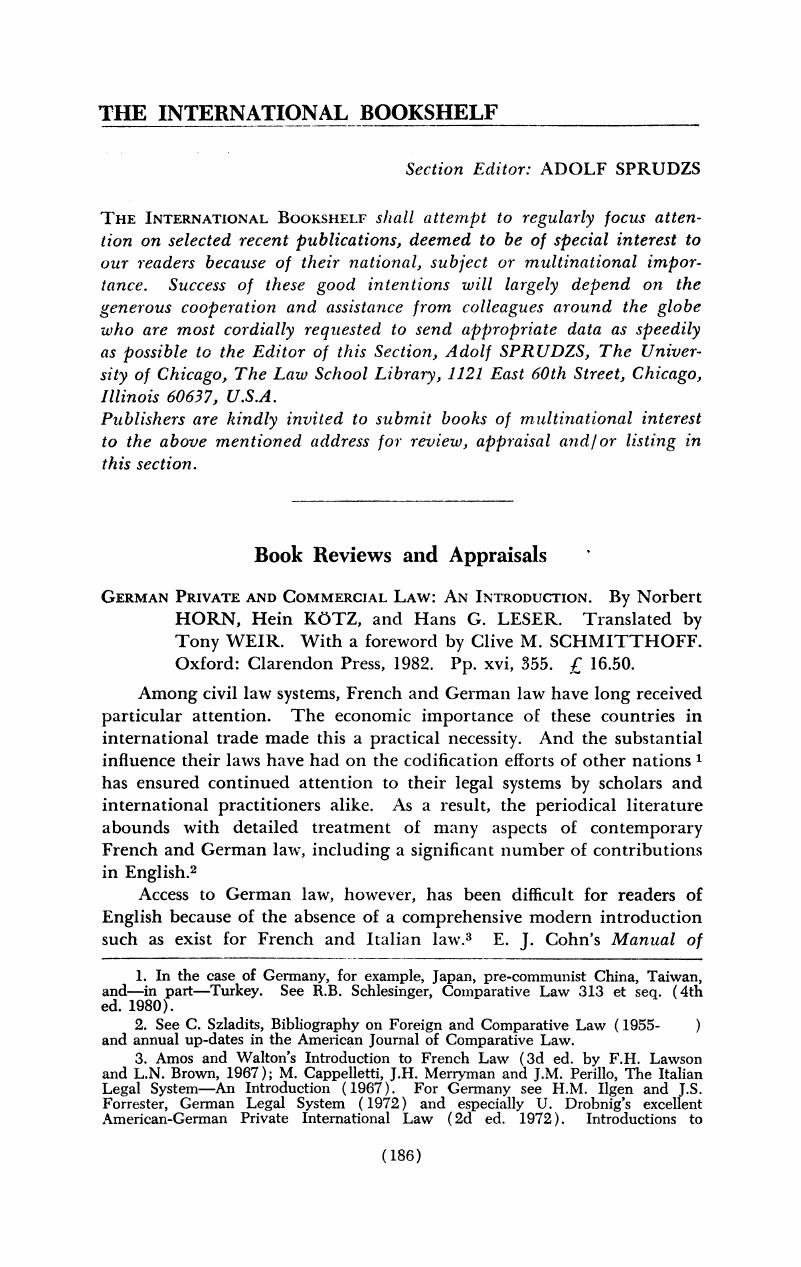No CrossRef data available.
Article contents
German Private and Commercial Law: An Introduction. By Norbert Horn, Hein Kötz, and Hans G. Leser. Translated by Tony Weir. With a foreword by Clive M. Schmitthoff. Oxford: Clarendon Press, 1982. Pp. xvi, 355. £ 16.50.
Published online by Cambridge University Press: 28 February 2019
Abstract

- Type
- The International Bookshelf
- Information
- Copyright
- Copyright © 1982 by International Association of Law Libraries
References
1. In the case of Germany, for example, Japan, pre-communist China, Taiwan, and—in part—Turkey. See R.B. Schlesinger, Comparative Law 313 et seq. (4th ed. 1980).Google Scholar
2. See Szladits, C., Bibliography on Foreign and Comparative Law (1955-) and annual up-dates in the American Journal of Comparative Law.Google Scholar
3. Amos and Walton's Introduction to French Law (3d ed. by Lawson, F.H. and Brown, L.N., 1967); Cappelletti, M., Merryman, J.H. and Perillo, J.M., The Italian Legal System—An Introduction (1967). For Germany see Ilgen, H.M. and Forrester, J.S., German Legal System (1972) and especially U. Drobnig's excellent American-German Private International Law (2d ed. 1972). Introductions to American law for German and other foreign audiences are more numerous: D. Blumenwitz, Einführung in das anglo-amerikanische Recht (JuS No. 2, 1971); E.A. Farnsworth, An Introduction to the Legal System of the United States (1963); Hay, P., An Introduction to U.S. Law (In German 1975; in English 1976); Parker, R., Das Privatrecht der Vereinigten Staaten von Amerika (1960).Google Scholar
4. Vol. I: Introduction and German Civil and Commercial law (1st ed. 1951, 2d ed. 1968), Vol. II: Private International Law, Civil Procedure, Criminal Law and Procedure (1st ed. 1952, 2d ed. 1971).Google Scholar
5. Respectively: Historical Introduction, Constitutional Law, The Administration of Justice (structure of the court system), and the sources of German law. While all of these are important to a reader requiring a basic institutional orientation before dealing with the law itself, the last two of these chapters are particularly important and effective.Google Scholar
6. The authors follow a practice to which this reviewer is also partial (Hay, supra n. 3, German ed.): German technical terms are used in the text, fully explained in their theoretical and practical aspects, and thereafter used in the original in subsequent discussion. In this fashion the reader receives subtle training in the meaning and application of the terms. The index noted in the text provides access to the discussion for the reader who starts his inquiry with knowledge of only the term but not its context or who seeks crossreferences to other parts of the book.Google Scholar
7. Foreign legal terms and concepts are difficult enough to translate, the more so when a concept or maxim is linguistically archaic. An example of the latter is the phrase “der Tote erbt den Lebendigen.” A natural, but obviously absurd translation would be “the dead inherits the living” (compare, in a different context, Beecher, Wills and Estates Under German Law 18 (1958)). Mr. Weir's elegant, and accurate, rendition is: “the dead vest the living” (p. 196).Google Scholar
8. See also Hay, Frustration and Its Solution in German Law, 10 Am. J. Comp. L. 345 (1961).Google Scholar
9. The rules for choice of law in the conflict of laws are perhaps the best example of the importance of judge-made rules in German law. Only a handful of provisions in the Introductory Law to the BGB address the subject; the area is thus largely left to the case law. The present volume provides a very brief summary at pp. 202–208. For an excellent treatment of the subject see U. Drobnig, supra n. 3.Google Scholar




